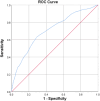Prediction of gestational diabetes mellitus using early-pregnancy data: a secondary analysis from a prospective cohort study in Iran
- PMID: 39716122
- PMCID: PMC11667930
- DOI: 10.1186/s12884-024-07079-6
Prediction of gestational diabetes mellitus using early-pregnancy data: a secondary analysis from a prospective cohort study in Iran
Abstract
Background: Early identification of gestational diabetes mellitus is essential for improving maternal and neonatal outcomes. While risk factors such as advanced maternal age, elevated pre-pregnancy body mass index, multiparity, and a history of gestational diabetes have been recognized, the role of serum biomarkers remains uncertain. This study explores the predictive value of early-pregnancy laboratory findings in conjunction with maternal demographic and clinical characteristics for gestational diabetes mellitus.
Methods: Early-pregnancy data from the first pregnancy visits at 6-12 weeks of gestation from women in the Mothers and Children's Health cohort were collected. Comprehensive maternal demographic data (e.g., age and body mass index) and obstetrics history (e.g., gravidity, parity, miscarriage, intrauterine growth retardation, gestational diabetes mellitus, and preeclampsia) were recorded. Maternal blood samples were analyzed for complete blood count and biochemistry parameters. Gestational diabetes mellitus was diagnosed based on 75-g oral glucose tolerance test results between 24 and 28 weeks of gestation, following the International Association of Diabetes and Pregnancy Study Groups criteria. Multivariate logistic regression analysis assessed the predictive capacity of various variables. Receiver operating curve analysis was conducted to identify optimal predictive cut-offs for continuous variables.
Results: 1,565 pregnant women with a mean age of 32.6 ± 5.7 years, mean body mass index of 25.5 ± 4.9 kg/m², mean gravidity of 1.1 ± 1.1, and mean parity of 0.8 ± 0.8 were included. 297 pregnancies (19.0%) were complicated by gestational diabetes mellitus. In the multivariate analysis, higher maternal age (p < 0.001, odds ratio = 1.076 [1.035-1.118]), a history of gestational diabetes mellitus (p < 0.001, odds ratio = 3.007 [1.787-5.060]) and preeclampsia (p = 0.007, odds ratio = 2.710 [1.310-5.604]), and elevated early-pregnancy fasting blood sugar (p < 0.001, odds ratio = 1.062 [1.042-1.083]) emerged as independent predictors of gestational diabetes mellitus. Moreover, the receiver operating curve yielded an optimal cut-off of 89.5 mg/dL for early-pregnancy fasting blood sugar in predicting gestational diabetes mellitus.
Conclusions: Our findings demonstrated that, in addition to established risk factors, a history of preeclampsia and elevated early-pregnancy fasting blood glucose are independent predictors of gestational diabetes mellitus. Therefore, close monitoring of pregnant women with these risk factors in early pregnancy is warranted to facilitate timely diagnostic and therapeutic interventions, reducing the burden of gestational diabetes.
Trial registration: Not applicable.
Keywords: Fasting blood sugar; Gestational diabetes mellitus; Prediction; Pregnancy complications.
© 2024. The Author(s).
Conflict of interest statement
Declarations. Ethics approval and consent to participate: The MATCH cohort study protocol received approval from the institutional review board and ethical committee of the Tehran University of Medical Sciences on October 12, 2019, under reference code IR.TUMS.MEDICINE.REC.1398.576 (available at https://ethics.research.ac.ir/PortalCommittee.php?code=IR.TUMS.MEDICINE.REC ). Also, prior to enrollment, participants received explicit verbal and written explanations of the study, and informed consent was obtained for both participation and the anonymous publication of their data. Participants were allowed to withdraw from the study at any stage without affecting their routine prenatal or postnatal care. Consent for publication: Not applicable. Competing interests: The authors declare no competing interests.
Figures
Similar articles
-
The Clinical Values of Afamin, Triglyceride and PLR in Predicting Risk of Gestational Diabetes During Early Pregnancy.Front Endocrinol (Lausanne). 2021 Nov 3;12:723650. doi: 10.3389/fendo.2021.723650. eCollection 2021. Front Endocrinol (Lausanne). 2021. PMID: 34803906 Free PMC article.
-
Accuracy of Fasting Blood Glucose and Body Mass Index in Predicting Gestational Diabetes Mellitus in China.Endocr Metab Immune Disord Drug Targets. 2024;24(8):967-972. doi: 10.2174/0118715303247457231018080709. Endocr Metab Immune Disord Drug Targets. 2024. PMID: 37929734
-
Triglyceride-glucose index in early pregnancy predicts the risk of gestational diabetes: a prospective cohort study.Lipids Health Dis. 2024 Mar 25;23(1):87. doi: 10.1186/s12944-024-02076-2. Lipids Health Dis. 2024. PMID: 38528508 Free PMC article.
-
Screening and diagnosing gestational diabetes mellitus.Evid Rep Technol Assess (Full Rep). 2012 Oct;(210):1-327. Evid Rep Technol Assess (Full Rep). 2012. PMID: 24423035 Free PMC article. Review.
-
[Gestational diabetes mellitus (Update 2019)].Wien Klin Wochenschr. 2019 May;131(Suppl 1):91-102. doi: 10.1007/s00508-018-1419-8. Wien Klin Wochenschr. 2019. PMID: 30980150 Review. German.
Cited by
-
Comparing umbilical cord arterial blood gas findings in pregnancies with and without gestational diabetes mellitus following elective cesarean section: a multicenter retrospective cohort study in Iran.BMC Pregnancy Childbirth. 2025 Apr 9;25(1):412. doi: 10.1186/s12884-025-07522-2. BMC Pregnancy Childbirth. 2025. PMID: 40200200 Free PMC article.
References
-
- Metzger B, Lowe L, Dyer A, Trimble E, Chaovari «dr U, Cousta, «DR, et al. The HAPO Study Cooperative Research Group. Hyperglycemia and adverse pregnancy outcomes. N Engl J Med. 2008;358(19):1991–2002. - PubMed
MeSH terms
Substances
LinkOut - more resources
Full Text Sources



